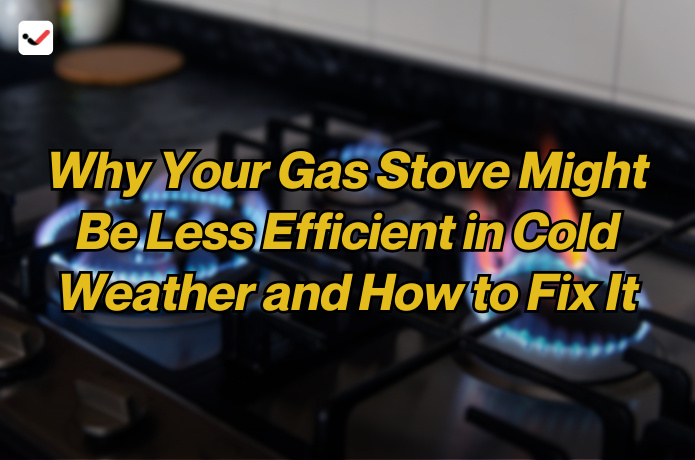Why Your Gas Stove Might Be Less Efficient in Cold Weather and How to Fix It
Why Your Gas Stove Might Be Less Efficient in Cold Weather and How to Fix It

As winter sets in and the temperature drops, many of us start relying more heavily on our gas stoves to keep our homes warm and cook our meals. However, you might notice that your gas stove seems less efficient than usual during these colder months. The flame may appear weaker, cooking times may increase, and your energy bills might rise. Understanding why your gas stove works differently in cold weather is important for both saving money and ensuring your stove runs optimally. In this article, we’ll explore the reasons behind your gas stove’s reduced efficiency during winter and offer simple solutions to fix it.
Gas stoves, like many household appliances, can be affected by the weather and the environment around them. While the stove itself is designed to operate consistently, changes in temperature, airflow, and gas pressure can all impact its performance. By addressing these factors, you can restore the efficiency of your gas stove, ensuring that it works as expected even during the coldest months of the year. Let’s take a look at the common reasons why your gas stove might be struggling in cold weather and how you can fix it.
1. Low Gas Pressure
One of the most common reasons your gas stove may perform poorly during the colder months is low gas pressure. Gas lines can contract in extremely cold temperatures, reducing the flow of natural gas or propane to your stove. This decrease in pressure can cause the flame to appear weaker or smaller than usual, which affects the stove’s ability to heat up quickly or cook food evenly.
To fix this, check if the gas line is exposed to the cold or if there are any blockages. If you suspect a problem with the gas pressure, it's best to contact a licensed professional to inspect the lines. They can check for leaks or damage and ensure that the gas pressure is up to standard. Additionally, if your home uses propane, make sure that the propane tank is kept in a location where it won’t freeze, as frozen tanks can lead to insufficient gas flow.
2. Poor Ventilation
Another factor that can make your gas stove less efficient in cold weather is poor ventilation. Stoves rely on a constant flow of air for proper combustion, and in winter, it’s common for homes to be more tightly sealed in order to conserve heat. While this can be great for keeping warm air inside, it can also restrict airflow to your stove, causing it to burn less efficiently.
To improve ventilation, consider installing an exhaust fan or ensuring that your kitchen is well-ventilated. Even opening a window slightly while cooking can help improve airflow and allow the gas stove to burn more efficiently. Make sure the exhaust hood or vent above your stove is clean and working properly to help remove excess heat and moisture from the cooking process.
3. Temperature Differences Inside Your Home
Cold temperatures outside can also affect the overall temperature inside your home, especially in rooms far from the heating source. If your kitchen is colder than usual, it can make it harder for your gas stove to maintain a steady flame. In colder rooms, the heat generated by the stove may dissipate too quickly, causing longer cooking times and increased energy use.
You can combat this by ensuring your kitchen remains at a comfortable temperature. Consider using a space heater in the kitchen if it tends to get too cold. Additionally, if your stove is located near windows or exterior walls, try to add insulation to prevent heat from escaping, which will help your stove work more efficiently.
4. Clogged Burner Ports
Another reason your gas stove may seem less efficient in cold weather is clogged burner ports. Over time, grease, food particles, and dust can accumulate on the burner ports, leading to uneven flames or a weak flame. In cold weather, this can become more noticeable because the reduced warmth can make the buildup harder for the stove to compensate for.
Cleaning your burner ports regularly is essential for maintaining the stove’s efficiency. Turn off the gas and allow the burners to cool before cleaning them. You can use a soft brush or a toothpick to gently clean out any debris from the burner ports. For stubborn buildup, a mixture of water and vinegar can help break down grease. Regular cleaning will ensure that the burners function efficiently, even when the temperature drops.
5. Malfunctioning Thermocouple
A thermocouple is a safety device on most gas stoves that detects whether the pilot light is lit and allows gas to flow to the burners. In cold weather, the thermocouple can become less sensitive, causing it to fail to detect the pilot light and prevent gas from flowing to the burners. This can lead to the stove not working at full capacity or not working at all.
If you notice that your stove is struggling to ignite or has an inconsistent flame, the thermocouple might be the issue. In this case, it’s a good idea to call a professional to check and replace the thermocouple if necessary. This is a simple fix that can restore your stove’s full functionality.
6. Gas Stove Age
Like any appliance, your gas stove’s age can also impact its efficiency. Older stoves may have worn-out components, such as clogged burners or malfunctioning parts, that make them less effective during cold weather. Over time, gas stoves lose their ability to heat up quickly and consistently, leading to longer cooking times and higher energy bills.
If your gas stove is over 10 years old, it may be time to consider an upgrade. Modern gas stoves are designed to be more energy-efficient, which can save you money in the long run. Look for stoves that have energy-efficient features, such as electronic ignition, which reduces the need for a constantly burning pilot light. An upgrade can improve cooking times and reduce your energy consumption during the colder months.
7. Frozen Gas Lines
In some extreme cases, if you live in an area with very cold temperatures, the gas lines feeding your stove can freeze. This happens when the temperature drops too low, and the gas within the line solidifies. Frozen gas lines are a serious issue and can stop the gas from flowing completely, making your stove completely inoperable.
If you suspect that your gas lines are frozen, it’s essential to contact a professional to inspect and thaw the lines safely. Avoid using any open flames or heat sources to thaw the lines yourself, as this can be dangerous. A professional can help you take the necessary steps to thaw the lines and prevent them from freezing again in the future.
Cold weather can significantly impact the performance of your gas stove, leading to reduced efficiency, increased cooking times, and higher energy costs. By understanding the factors that contribute to these issues and implementing simple solutions, you can keep your stove running smoothly throughout the winter. Regular maintenance, such as cleaning the burners, checking the gas pressure, and ensuring proper ventilation, can help restore your stove’s efficiency. If problems persist, don't hesitate to contact a professional for a thorough inspection. With the right care and attention, your gas stove will continue to serve you well, no matter how cold it gets outside.

